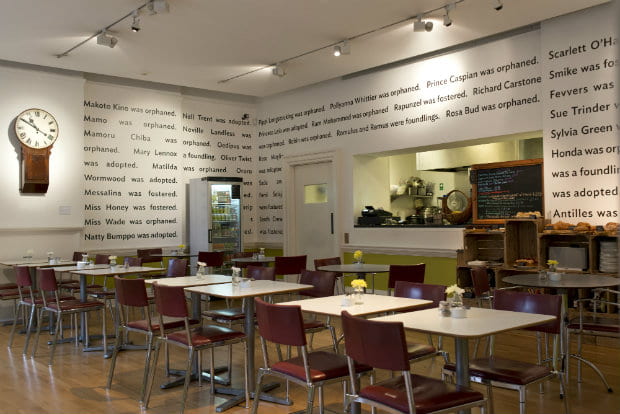Superman was a foundling: art that draws on childhood
By Blog Editor, IOE Digital, on 15 April 2016
Heather Elliott.
Superman was a foundling. Ann Shirley was adopted. James Bond was fostered. The poet, Lemn Sissay, who spent some of his teenage years in care, has covered the walls of the cafe of the Thomas Coram Foundling Museum with the names of fictional heroes who grew up outside nuclear families. This work is the starting point for the museum’s current exhibition, Drawing on Childhood, which explores why literature’s most beloved sons and daughters are all alone in the world. The show is bookended by illustrations of foundlings Tom Jones and Jacqueline Wilson’s Dustbin Baby, taking in along the way Rapunzel and Snow White, Jane Eyre and Peter Pan, Roald Dahl’s James Trotter and Harry Potter.
The Foundling Hospital was established by Thomas Coram in 1739 as a home for London’s abandoned children and the museum is the perfect setting for this exhibition. It also has a special connection with the Institute of Education. Our Thomas Coram Research Unit has been researching children in the city and the institutions and families who care for them for 40 years. We focus, in particular on the marginalised and displaced and how their lives are storied, children who are migrants and who are in care, for example, or living in poverty.

Lemn Sissay’s mural Superman was a Foundling
Coram’s campaigning concern for London’s children is reflected in the exhibition, too. Illustrations for Dickens’ Little Dorrit draw out the psychological and material deprivations of families living in poverty (the novel features the housemaid ‘Tatty Coram’, who grew up in the foundling hospital) while Charles Kingsley’s The Water Babies was instrumental in raising awareness about child labour. The Chimney Sweepers’ Regulation Act was passed in 1864, a year after the book’s publication, showing us the power if a well told story.
Why this fascination with the motherless child? It is, of course, narratively useful for writers to separate children from their parents so they can find their own way in the world. There are no parents in this exhibition apart from Angela Barrett’s poignant portrait of Snow White’s mother, an empty cradle in the background ready for the child she will never know. Otherwise, children are at the mercy of stepmothers, aunts and uncles, of strangers and institutions. Jane Eyre cowers in the corner of the red room where her uncle died, furniture looming darkly around her. Harry Potter fills the whole of the understairs cupboard where he was shut up, hugging his knees, watching a spider, his eyes resigned and sad behind his trademark glasses. In contrast to the evil architecture of these prisons for one, the natural world is seen as offering solidarity and solace – as the Jungle Book reminds us, to be raised by wolves is to be raised with integrity, respect and care.
Through the figure of the child, then, writers and artists can explore extremes of human vulnerability, isolation and interdependence. These explorations are made bearable by children’s capacity for hopefulness and play. As this exhibition suggests, in stories, if not in life, there are happy endings for those who can believe in magic.
Christopher Haughton’s illustration for Tom Jones, one of three works specially commissioned for the show, portrays a baby lying alone on a massive four poster bed, his life hanging in the balance as adults debate whether to take him in or abandon him. In the notes accompanying the illustration, Haughton makes a connection between the arguments raised by some of Coram’s critics, that helping homeless children would only encourage more mothers to abandon their babies and contemporary attitudes to displaced and desperate people crossing the Aegean sea from Syria. In Mabel Lucie Atwell’s drawing for Peter Pan, a child flies through the sky in buttoned up striped pyjamas, staring at the world below and beyond, oblivious to the tiny green goblins which catch at the legs and elbows of the older children around him.
They do not want us to land, it is called.
The exhibition runs until 1 May.
Heather Elliott’s novel Paradise Rocks has been long listed for the Times/Chickenhouse prize for children’s fiction.
Illustration: Snow White’s Mother by Angela Barrett
One Response to “Superman was a foundling: art that draws on childhood”
- 1
 Close
Close




Lovely write up 🙂
I loved this exhibition because a lot of the drawings triggered memories of being read to as a child, of overcoming whole ranges of emotion, of knowing those characters, and somehow having consoled with them #artmemos 🙂